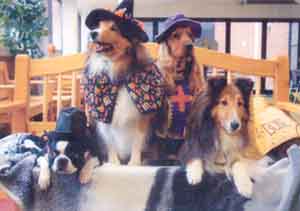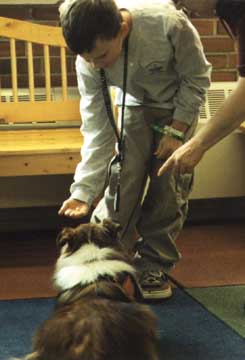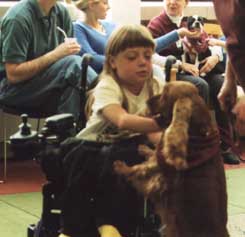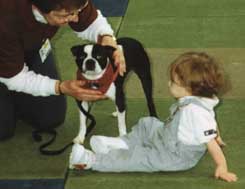
Ask any companion animal owner and he or she will tell you how wonderful their pets are. For most pet owners their animals quickly become much-loved members of the family. Sometimes, a dog, or a cat, a bird, even a snake is the only family they have. Anyone who has experienced a strong bond with a companion animal knows this to be true. Those who haven’t may not understand, and are the poorer for it, because there is something primal, basic, and deeply embedded in human nature that is the only explanation for the close bond and emotional ties humans have with animals. Just how strong the social relationship between humans and animals is has been documented by over two decades of research, both in the laboratory and by community-based observation and study. The increasing bulk of literature seems to have well established the benefits of human-animal interaction to human health and well-being. Some of these studies produce evidence that pets can aid in stress reduction, reduce high blood pressure, increase heart attack survival rates, enhance rehabilitation for stroke victims, increase exercise, improve speech, balance and fine motor skills, reduce anxiety, loneliness and improve social skills and overall mental health. The list of benefits goes on. Consider the incident several years ago in Scottsdale, Arizona where a six-year-old boy was in a coma following a violent highway collision in which he received a traumatic head injury. The boy, otherwise uninjured, was unresponsive for weeks. His anxious parents were heartbroken. Then, one day, the boy was visited by a volunteer and her golden retriever. The injured boy also had a golden retriever at home. The dog jumped up, placing his two front paws on the side of the boy’s bed and licked his face. At first there was no response. Then, the volunteer gave the dog a command to “speak” and the dog barked. At that point the boy turned his head and opened his eyes. It was not an immediate cure, the boy’s recovery took weeks. But the boy’s parents, doctors and nursing staff agreed that his awakening was sparked that day by the interaction with a therapy dog. Eventually, his recovery was complete. What happened? The boy in Scottsdale didn’t react to his parents’ voices, his doctor’s stimuli, or all the other efforts to retrieve him from his coma. But a dog’s bark was not only heard, but motivated the boy to re-enter the world of the living. Closer to home, a few weeks ago at Strong Children’s Hospital in Rochester, a tall, thin 12-year-old boy apprehensively entered a sun-drenched playroom away from the medical unit where he was a patient. He was dressed not in hospital clothing, but as any 12-year-old from Pittsford might dress to go to school. The handsome boy, accompanied by his father, moved apprehensively across the room where he stuffed himself into a corner, hands in his pockets, head bowed, shoulders slumped forward. In the middle of the room, surrounded by half-a-dozen other children, Strong PETS volunteers with three other dogs, stood “Dr. Rickey,” straining at his leash, leash held by his owner Ann Lacey, to greet the boy. Lacey and Rickey moved gracefully forward to meet the newcomer. When they were about a yard away, the boy, visibly upset, yelled, “Go away, get ’em away!” Lacey calmly took hold of Rickey’s leash and stepped back. She reassured the boy, introduced Rickey and withdrew. Temporarily. Lacey has been visiting Strong Children’s Hospital and other regional medical facilities, nursing homes, and residential institutions for twenty years. Dr. Rickey, a 10-year old Sheltie, is her second therapy dog. She has been employed by the University of Rochester since 1994 to provide animal-assisted activities for the recreational therapy department. The Strong program is called Pets Engaged in Therapeutic Socialization or PETS. There are five dogs in the program at the present time, three shelties, a Boston terrier and a cocker spaniel. The dogs’ owners are all Friends of Strong volunteers. Anita Burton, Senior Recreational Therapist at Strong says, “These dogs have been through extensive training and screening. The dogs must be certified by one of two organizations: Therapy Dogs International or Delta Partners. They are temperament-tested and checked by a vet twice a year. Before a patient can spend time with a Strong PET, permission from parents, doctors, and, in some cases, roommates must be granted.” Delta Partners is run by the Delta Society, an international non-profit organization based in Oregon. Besides certifying therapy dogs, they sponsor research into the human-companion animal relationship and advocate in the public arena for policy that allows animals in public (and private) housing, senior assisted-living facilities and medical venues. The Delta Society defines pet therapy as any animal-assisted activity designed to promote improvement in human physical, social, emotional or cognitive functioning. By this, or any definition, what happened with the boy at Strong Children’s Hospital that sunny day in March was therapeutic. Because, within a few minutes in the presence of Rickey and the other dogs, that sullen, apprehensive 12-year-old, not only allowed Rickey to approach and greet him, but he was stroking, feeding and walking with the dog. Twenty minutes later, under the boy’s command, Dr. Rickey, the therapy dog, was sitting, speaking, twirling around, rolling over and jumping through hoops of fire engaging an otherwise discouraged, shy, inactive child in the kind of play and exercise that, by all accounts, heals. It was quite a thing to see. Dr. Rickey: Wednesday’s Promise is a “warm, soft and cheerful” book written by Ann Lacey and Barbara Wunder Pratt which describes for children (of all ages) the role of a therapy dog. The book is illustrated by local artist Michael Sparling. Check local libraries or contact Dr. Rickey, PO Box 239, Spencerport, NY 14559. 585-352-1414. Healthy reasons to have a pet
|




